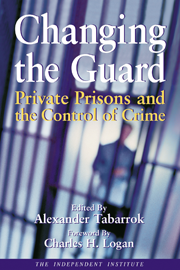Crime rates, according to FBI reports, fell about 16 percent per 100,000 population from their 1991 peak to 1997 and fell another 7 percent in 1998. There is no shortage of explanations offered for this significant decline. Politicians claim credit because of their support for prison construction, longer mandated sentences, greater police funding, or policies that reduce unemployment and incentives to commit property crimes. Police point to innovative strategies such as "community policing." Criminologists cite many of these same causes, along with the shrinking population of crime-prone young males.
No doubt many of these factors help explain falling crime rates, but there is another, perhaps more important, cause which has gone largely unnoticed: private citizens’ growing investments of time and money in security.
Private crime control – including voluntary watch, patrol and escort arrangements, alarms, improved locks and better lighting, self-protection, and private security personnel – has been a growth industry for decades. A 1970 estimate put private security personnel at roughly equal to public police, but by 1990 there were about 2.5 private security personnel for every public police officer. Today, the ratio is probably at least three to one. Private security is the second fastest growing industry in the country, but increasing employment is only part of the story.
Consider the market for security alarms. Alarm sales increased by about 11 percent per year in 1970, but this growth rate reached 15 percent in 1990. In 1970, one percent of U.S. homes were connected to central alarm systems. By 1990, one in ten homes were. And this trend appears to have accelerated in the 1990s, as has the sale of other electronic equipment to control access, detect intrusion, and protect vehicles, along with closed-circuit television, metal detectors, x-ray devises, and other security technology.
The rise in private crime control is also illustrated by the growing number of enclosed shopping malls, office complexes, and residential buildings created with security as one design goal. A 1997 estimate suggested that 24 million Americans lived in limited-access condominiums, apartment complexes and cooperatives. Beyond that, private residential communities consisting of large numbers of single and/or multiple family homes on private streets, are also increasingly offered with security as one selling point. A 1997 estimate put the number of people in "gated" communities at around eight million. What do these consumers think they are getting?
The case of Starrett City, a gigantic, 153-acre complex in the high-crime East New York section of Brooklyn, helps explain the popularity of such communities. By the 1980s about 20,000 racially and ethnically diverse but largely middle-income residents lived in its 5,881 apartment units in 56 buildings. A 1986 study by Penn State criminologists Edwin Donovan and William Walsh found that Starrett City residents were much more likely to actually report crimes to their security personnel than citizens in general are, and yet Starrett City had only 6.57 reported crimes per 1000 population, compared to 49.86 for the 75th precinct in which Starrett City is located. At the time of the study, Starrett City had a private security force of 54 people, including 34 officers with general patrol duties, a 6-officer K-9 unit, and a 5-officer unit which patrolled in civilian clothes.
Other communities adopting private security see comparable improvement. Critical Intervention Services, private security agency in Florida, provides security to apartment complexes priced to attract low-income tenants. Crime drops by an average of 50 percent after CIS secures a complex (50 where under contract in Miami, Tampa, Jacksonville, and Orlando by 1996). This may be partly attributable to the prodigious community work the agency undertakes. CIS employees play ball with kids, help with homework, distribute Christmas presents to needy youngsters, and otherwise avail themselves to young residents. As the firm’s founder, K. C. Poulin, said "once you get to know the kids and their parents, crime goes down."
A 1992 statistical study by Edwin Zedlewski, a senior advisor to the National Institute of Justice, comparing public and private security in 124 Standard Metropolitan Statistical Areas further strengthens the case for private security. The study found that devoting more resources to public police didn’t seem to deter more crime, while devoting more to private security did. This should come as no surprise, since private entrepreneurs – unlike public bureaucrats – are under constant competitive pressure to discover new ways to improve their products and services, including discovering new ways to improve community cooperation. Clearly, private entrepreneurs, and the public they work with, deserve much of the credit for falling crime rates.















